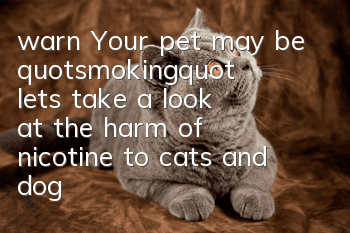warn! Your pet may be "smoking", let's take a look at the harm of nicotine to cats and dogs!

Recently, Zhangjiakou and Wuhan have successively passed local tobacco control provisions. So far, there are more than 20 “smoke-free cities” across the country.
There are more and more laws and regulations to protect Twolegs from being exposed to second-hand smoke. But have pets been exposed to second-hand smoke, have we paid any attention to it?
Not only do pets inhale secondhand smoke during breathing, but they also ingest nicotine attached to their fur when they groom themselves.
In addition, they live in lower places, sleeping on (trampled on) sofas, carpets and beds, and rubbing (tearing down) furniture and walls, all have third-hand smoke stuck to them.
Note: There are more than 7,000 chemicals in secondhand smoke, including at least 70 chemicals that can cause cancer. Third-hand smoke refers to tobacco/smoke residue attached to carpets, furniture, clothing or skin, and contains more than 250 chemical substances.
Second-hand and third-hand smoke are harmful to the health of pets. When faced with nicotine, pets have nowhere to escape.
Because cats and dogs have different habits and physiological structures, the harm of nicotine to them is also different.
When long-nosed dogs (such as collies) are exposed to secondhand smoke for a long time, the risk of nasal cancer more than triples!
This is because the long nose sticks out, filters out the toxins in cigarette smoke, and protects the lungs, drastically reducing the possibility of lung cancer.
Dogs with short or medium noses (such as pugs and bulldogs) are at high risk for lung cancer under similar conditions! Because these same toxins enter and damage the lungs more directly, dogs hide Even if you have nasal cancer, you cannot avoid lung cancer.
Cat's lungs are almost the same as human lungs, if not smaller. Cats who live in an environment of second-hand smoke for a long time are more than three times more likely to develop lymphoma than cats who live in a smoke-free environment!
Since cats have the habit of grooming, when grooming their hair, toxins slowly accumulate in the cat’s mouth. Therefore, the ingestion of third-hand smoke also increases the risk of oral cancer in cats.
Dogs that don’t like to lick their hair don’t have this concern. But the cat never thought that how could he become a "drug addict" while he was busy grooming himself and striving to be a good student?!
Secondhand smoke can cause damage to the lining of your pet’s respiratory tract and may cause chronic bronchitis and asthma.
After close contact with third-hand smoke, skin allergy symptoms may come to your door. How can we discuss marriage with a pet with a rotten face?
The above diseases are an accumulation from quantitative changes to qualitative changes. But if they just chew the butt of cigarettes out of damn curiosity,How can you stand up to ingesting large amounts of tar, nicotine, and other harmful toxins?!
Symptoms of nicotine poisoning occur at doses as low as 1mg/kg, with the lethal dose in most dogs being 9.2mg/kg. In other words, families raising small pets need to pay more attention to the harm caused by nicotine to their pets.
The average cigarette (depending on brand and blend) contains 13-40 mg of nicotine. Calculated in this way, no matter how tall or short you are, fat or thin, as long as your master has a cigarette, he may go to the west (unlucky, bah).
Symptoms generally appear within 15 to 90 minutes. The amount of intake and body size will affect whether the symptoms of poisoning are obvious or not.
■ Overexcitability or irritability ■ Chronic vomiting, diarrhea, dehydration ■ Coughing, shivering ■ Excessive drooling ■ Mydriasis ■ Seizures, coma
■Nicotine stimulates nerves and can cause spontaneous vomiting. This is also their way of actively saving themselves, trying to eliminate harmful substances through vomiting.
■ If there is no vomiting, you can induce vomiting appropriately to encourage vomiting out most of the ingested substances and try to prevent more nicotine from being absorbed.
■It is precisely because the reaction to nicotine poisoning comes so quickly, like a tornado
■ If the pet is still alive 4 hours after treatment, it means that their liver has defeated nicotine, and the toxin residue will be metabolized and cleared after 16 hours.
■ For ventilation, use an air purifier or the old school ventilation method - open windows to circulate air in the room, allowing the fresh air to crowd out the remaining smoke from second-hand and third-hand smoke.
■ When smoking outside, try to smoke in the smoking room to keep pets clean.
■ Cleaning work: Wash your hands after smoking before touching pets; use wet wipes to clean cats to remove third-hand smoke residue from their hair.
■ When disposing of cigarette butts and throwing them into the trash can, are you giving your pet a chance to make a mistake?
■Be careful when licking second-hand smoke as it will remain on your clothes. Be careful not to let cats lick your clothes (if they don’t mind).
The scavengers who shoulder the responsibility of love and responsibility, think about it, are you willing to let your pets (who may not be) thin bear such a huge risk of disease?
If the answer is no, then consciously abide by this "smoking control order" to protect pets from second-hand and third-hand smoke~
《Framework Convention on Tobacco Control · Cute Pet Version》
Scope of smoking control: pet’s activity range
Punishment intensity: years of shoveling poop + 10 years; canned food and other snacks + 10 servings; to be added, and the right of interpretation belongs to the pet.
- When is the best age to neuter a cat?
- Symptoms and Treatment of Feline Coccidiosis
- Is it better for cats to eat cat food? The correct way to feed cats!
- Analysis of the causes of cats’ loss of appetite, a must-read for cat owners!
- How do cats vomit hairballs? How does a cat spit out hairballs to eat?
- Symptom classification and treatment methods of several common cat skin diseases
- What are the symptoms of cat kidney failure?
- The cat can’t walk when it puts on the shoes? How does the cat behave after putting on the shoes?
- Can cats drink milk? You will understand after reading this!
- The effects and efficacy of taurine on cats



